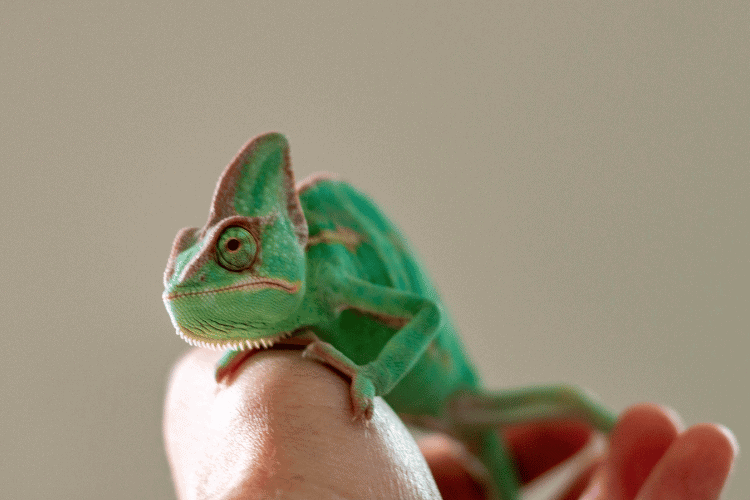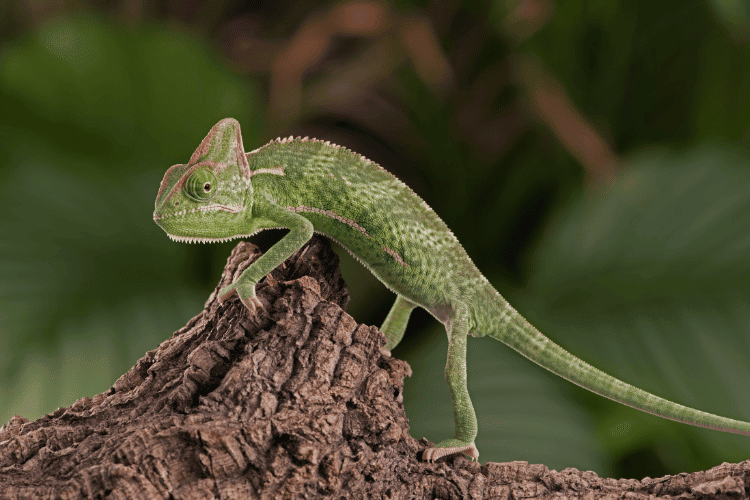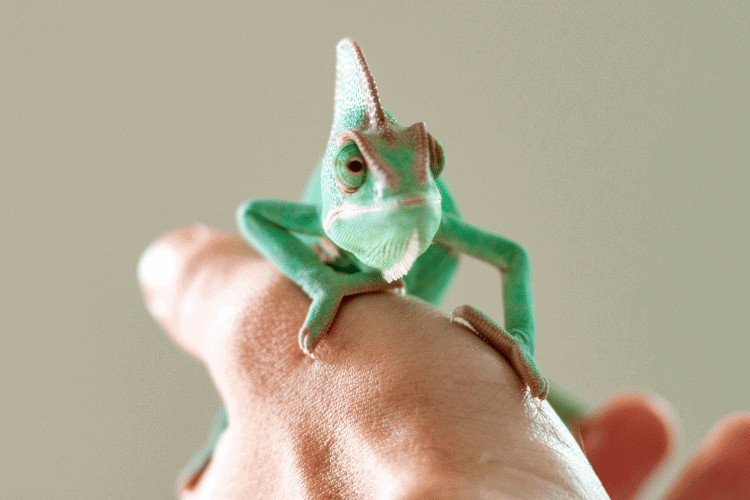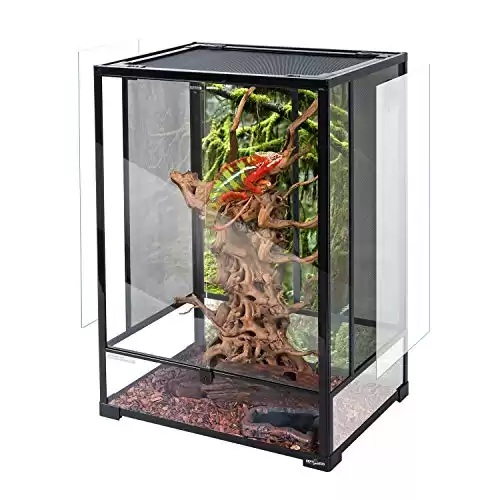If you’ve ever been enchanted by the world of chameleons, you’ve probably wondered: Do veiled chameleons like to be held?
In this article, we’ll uncover the secrets of these friendly chameleons, explore their personalities, and discover whether they enjoy some quality bonding time in your hands.
So, are you ready to meet the veiled chameleons up close and personal? Let’s find out!
Do Veiled Chameleons Like to Be Held?

This is the short answer: Veiled chameleons don’t particularly like being held by humans, most of the time.
To understand this reluctance, we can look at their evolutionary history that made them this standoff-ish to humans.
Why Don’t Veiled Chameleons Like to Be Held?
For centuries, chameleons roamed the wild, adapting themselves to evade danger and remain hidden. They are very secretive animals and they’ve never been accustomed to human touch or interaction.
Today, we’ve embraced them as pets, but they haven’t evolved alongside us like dogs or cats.
Chameleons, as a species, are incredibly sensitive creatures. They’re acutely attuned to movement, sound, and light, which means they can easily feel threatened when in an unfamiliar environment.
So, when you attempt to hold a veiled chameleon, you’re essentially subjecting them to a situation that goes against their natural instincts. They may perceive your touch as a potential threat, leading to stress – something that can be genuinely harmful to them and, in severe cases, even life-threatening.
While there are accounts of some chameleon species becoming comfortable enough to sit on your shoulder or hand, this behavior varies widely among individual chameleons.
It’s essential to remember that even if one veiled chameleon seems “friendly,” it doesn’t negate their overall sensitivity to handling.
And a key factor in this discomfort is their lack of defenses against potential threats. Unlike other pets, they can’t scratch or bite when they feel threatened.
Additionally, their skin is sensitive and delicate, making them susceptible to injuries from handling. As such, these arboreal creatures prefer to remain hidden in the trees, where they feel most secure.
Can You Teach a Veiled Chameleon to Like Handling?
While these creatures may not naturally gravitate toward human handling, it is indeed possible to build trust and reduce their fear over time.
The key to successfully handling a veiled chameleon is to approach it with patience and respect for its instincts. Unlike some other pets, these reptiles have innate survival instincts that make them wary of sudden movements and unfamiliar environments.
One crucial tip is to avoid forcefully grabbing your chameleon from its branches. Instead, encourage it to walk onto your hand voluntarily.
To teach your veiled chameleon to tolerate handling, you can take a more gentle approach.
How to Handle a Veiled Chameleon: The Right Way
These sensitive and shy creatures can easily become stressed or agitated if mishandled. So the best thing you can do is to not handle your chameleon at all. But if you are going to pick up the chameleon sometimes, it is important to make sure the chameleon is safe. Let’s explore the steps to handle your chameleon the right way.
Step 1: Be Calm When Approaching Your Chameleon
Approach your chameleon slowly and calmly, without startling them.
Spend a few minutes near their enclosure, allowing them to become accustomed to your presence. This gradual approach helps prevent stress and reduces the likelihood of aggressive behavior.
Avoid sticking your hand directly into their habitat too, as this could lead to a bite or defensive reaction. Patience is key during this initial phase.
Step 2: Use Food to Lure Them to You
One way to establish trust is by offering food directly from your hand. Place your hand inside the chameleon’s enclosure and offer them a feeder insect.
Regularly feeding them this way not only encourages bonding but also helps them associate your presence with something positive.
Step 3: Your Reptile Needs to Feel Safe
After they’ve had a meal, gently reintroduce your hand into the enclosure. Your chameleon may approach, expecting more food.
Let them come to you willingly, and avoid forcing the interaction. If they’re comfortable, they may even climb onto your hand.
Remember too that veiled chameleons have five grabbing points – their four feet and their incredible tail – which are always seeking something to hold onto. Snatching them forcefully can lead to accidents and injuries as well.
Pay attention to their body language; if they puff up or show signs of discomfort, it’s best to give them some space. Respect their boundaries.
Step 4: Keep Supporting Your Pet Chameleon
When you’re ready to pick them up, ensure they have a secure grip on your hand or fingers.
Chameleons prefer to hold onto objects, and your hand is new territory for them. Be patient, and they may eventually stay on your hand for longer periods.
Gently touching their back can signal that it’s okay to move forward. Gradually, as they become more accustomed to this, you can transition them from one hand to the other.
For larger chameleons, offering a branch or a flat palm under their chin for them to step onto can also work.
Step 5: Return the Chameleon to Its Home
When it’s time to return your chameleon to their
As they grasp the branch and climb up their habitat, you’ll see them safely back in their comfort zone.
What to Avoid When Handling a Veiled Chameleon

Handling your veiled chameleon can be a rewarding experience, but it’s equally crucial to be aware of what to avoid to ensure both your chameleon’s well-being and your safety.
1. Don’t Startle Your Chameleon
Veiled chameleons are easily stressed by sudden movements and unfamiliar environments.
Never startle your chameleon, as it can lead to heightened stress levels and even defensive bites.
Approach your chameleon or its habitat with the utmost gentleness to create a calm and secure atmosphere.
2. Avoid petting them
When your chameleon climbs onto you, give them time to get comfortable with your presence and explore their surroundings.
Avoid petting them; instead, let them settle and assess their comfort level. Chameleons have very sensitive skin, so it is best to avoid stroking or petting them.
3. Don’t Force Handling Time
Respect your chameleon’s boundaries and let them come to you naturally. Avoid pushing them or trying to make them climb onto your hand forcefully.
Chameleons have sharp teeth and can bite if they feel threatened or uncomfortable. It’s best to maintain a patient and gentle approach.
4. Always Approach From the Front
Chameleons perceive anything larger than them as potential predators, and birds often prey on them from above.
Avoid approaching your chameleon from above or behind, as this can trigger a defensive response, such as jumping or biting.
Always approach them from the front, allowing them to understand your intentions and feel less threatened.
5. One Chameleon at a Time
Chameleons are territorial creatures, and holding two chameleons together can lead to aggression and fights.
They may perceive the presence of another chameleon as a threat and react accordingly. It’s essential to keep chameleons separate to prevent potential harm to both reptiles.
How to Know When to Stop Handling a Veiled Chameleon
It’s equally important to recognize when it’s time to put your pet back in their enclosure to ensure their comfort and well-being.
These sensitive creatures communicate their discomfort through various body language cues, and it’s essential to respect their signals.
1. Gaping and Puffing
One of the clear signs that your chameleon feels uncomfortable is gaping, which involves opening their mouth. This behavior is often accompanied by puffing up their body, making themselves appear larger. It’s an indication that they feel threatened or stressed.
2. Running From You
Chameleons have a natural fight-or-flight response. If your chameleon attempts to run away from you during handling, it’s a clear signal that they are not in the mood for interaction.
Pushing them further could increase their stress, so respect their desire to retreat to a safe spot in their enclosure.
3. Biting
Biting is a last resort for chameleons when they feel extremely threatened or uncomfortable. It’s essential to avoid reaching this point by recognizing earlier signs of stress and responding accordingly.
If you persist in actions that distress your chameleon, they may resort to biting as a defensive measure.

4. Changing Bright Colors
Chameleons are known for their ability to change color. While this can be a response to environmental factors, such as temperature changes, it can also signal discomfort.
If your chameleon turns black or exhibits unusually bright colors when handled, it’s an indicator that they’re feeling stressed, threatened, or fearful.
5. Uncomfortable Hissing
Hissing is another vocalization that chameleons may use to express their discomfort.
If you approach them in a way that startles or stresses them, they may hiss as a warning. Pay attention to this signal and give them the space they need to calm down.
Summing Up: Do Veiled Chameleons Like to Be Held?
The answer is not really. They can’t like being held because they’re not used to it and they see you as a threat rather than a pet owner.
But you can teach your pet chameleon to not think of you as threatening. Slowly, and with lots of patience, they’ll learn to tolerate handling.
Just be aware of the stress-inducing risks and health concerns associated with handling chameleons beforehand.


